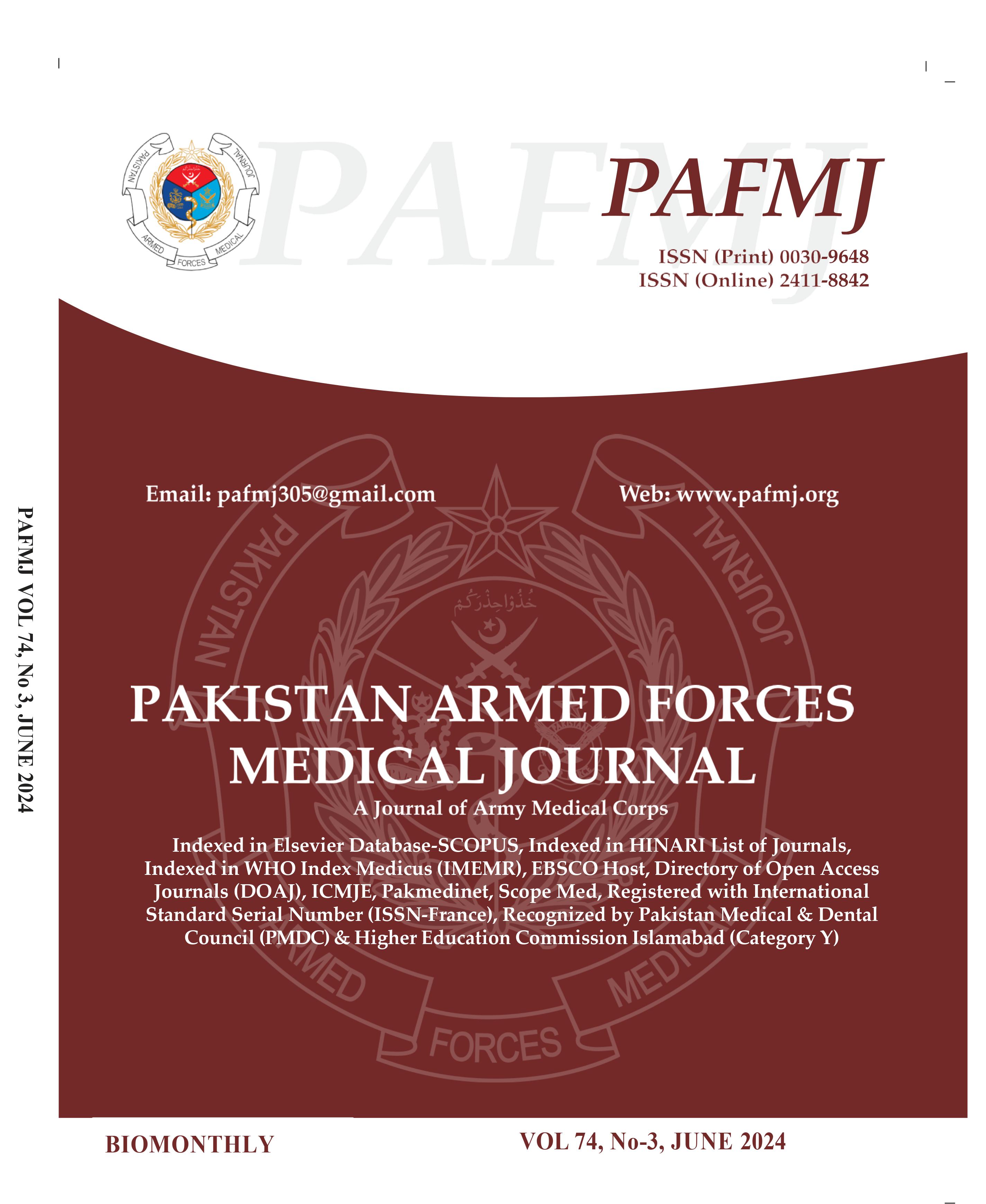Th Management and Complications of Staged Approach in Children with Anorectal Malformations; Experience at Tertiary Care Facility
DOI:
https://doi.org/10.51253/pafmj.v74i3.10053Keywords:
Anoplasty, Anorectal malformations, Rectovestibular fistula.Abstract
Objective: To present the data of children with anorectal malformations treated with a staged approach, including the complications of each stage.
Study Design: Prospective longitudinal Study
Place and Duration of Study: Paediatric Surgery Departments, Combined Military Hospital, Malir and Multan, Pakistan from Jan 2017 to Jun 2019 and Jul 2019 to Jul 2022, respectively.
Methodology: Twenty-four children with anorectal malformations were included. All were treated with a staged approach. The complications encountered during each approach were documented.
Results: A total of 24 patients were operated on. Fourteen (58.3%) were female, whereas 10 (41.7%) were male patients. The age range was 1-4 years, with a mean of 2.00 ± 0.97 years. Female patients had an ARM with a rectovestibular fistula. Two (20%) of the male patients had rectal atresia, a recto-urethral bulbar fistula, a recto-urethral prostatic fistula, a recto-bladder neck fistula, or a perineal fistula. Two (8.3%), three (12.5%), two (8.3%), and one (4.1%) patients who had stage 1 had stomal stenosis or retraction, wound dehiscence, wound infection, and stoma prolapse respectively. In the second stage, two patients (8.3% of all patients) had an infection, a wound dehiscence, a dehiscence of the perineal body, and anal stenosis. In the other patient, one (4.1%) had an anal mucosal prolapse and severe urethral injury. After stage 3, only one patient (4.1%) had a wound infection.
Conclusion: Patients with ARM are generally treated with a multistaged approach, and each stage of treatment has its own complications.
Downloads
References
Levitt MA, Pena A. Imperforate anus and cloacal malformations. In: Holcomb GW III, Murphy JP, editors. Ashcraft's Pediatric Surgery. 5th Edition, Philadelphia, PA: Saunders Elsevier; 2010.
Kluth D. Embryology of anorectal malformations. Semin Pediatr Surg 2010; 19(3): 201-208.
https://doi.org/10.1053/j.sempedsurg.2010.03.005
deVries PA, Peña A. Posterior sagittal anorectoplasty. J Pediatr Surg 1982; 17(5): 638-643.
https://doi.org/10.1016/s0022-3468(82)80126-7
Endo M, Hayashi A, Ishihara M, Maie M, Nagasaki A, Nishi T, et al. Analysis of 1,992 patients with anorectal malformations over the past two decades in Japan. Steering Committee of Japanese Study Group of Anorectal Anomalies. J Pediatr Surg 1999; 34(3): 435-441. https://doi.org/10.1016/s0022-3468(99)90494-3
Watanabe Y, Ando H, Seo T, Shinohara T. Three-dimensional image reconstruction of an anorectal malformation with multidetector-row helical computed tomography technology. Pediatr Surg Int 2003; 19(3): 167-171. https://doi.org/10.1007/s00383-002-0911-3
Zwink N, Jenetzky E, Brenner H. Parental risk factors and anorectal malformations: systematic review and meta-analysis. Orphanet J Rare Dis 2011; 6: 25.
https://doi.org/10.1186/1750-1172-6-25.
Gangopadhyay AN, Pandey V. Anorectal malformations. J Indian Assoc Pediatr Surg. 2015; 20(1): 10-15.
https://doi.org/10.4103/0971-9261.145438
Langemeijer RA, Molenaar JC. Continence after posterior sagittal anorectoplasty. J Pediatr Surg 1991; 26(5): 587-590.
https://doi.org/10.1016/0022-3468(91)90713-4
Kureel SN, Malik GK. Anorectal malformations: Practical tips. J Neonatol 2007; 21(4): 233-237.
https://doi.org/10.1177/097321790702100406
Kimura O, Iwai N, Sasaki Y, Tsuda T,. Laparoscopic versus open abdominoperinealrectoplasty for infants with high-type anorectal malformation. J Pediatr Surg 2010; 45: 2390–2393.
Elrouby A, Waheeb S, Khairi A, Fawzi O. Evaluation of the functional outcome of the neonatal one stage posterior sagittal anorectoplasty (PSARP) as a procedure to treat cases of high anorectal malformation in male neonates. Arch Clin Exp Surg 2018; 8(1): 7-14.
Tiwari C, Shenoy NS, Gandhi S, Makan A, Basu S, Tulsian A, et al. Primary Posterior Sagittal Anorectoplasty in male neonates with Anorectal Malformations: A tertiary care hospital experience. J Neonat Surg 2021; 10: 29.
https://doi.org/10.47338/jns.v10.953
Nour S, Beck J, Stringer MD. Colostomy complications in infants and children. Ann R Coll Surg Engl 1996; 78(6): 526-530.
Uba AF, Chirdan LB. Colostomy complications in children. Ann Afr Med 2003; 2(1): 9-12.
Tofft L, Salö M, Arnbjörnsson E, Stenström P. Wound Dehiscence after Posterior Sagittal Anorectoplasty in Children with Anorectal Malformations. Biomed Res Int 2018; 2018: 2930783.
https://doi.org/10.1155/2018/2930783
Elekiabi O. Risk Factors For Wound Dehiscence After Posterior Sagittal Anorectoplasty In Children With Anorectal Anomalies. Zagazig Uni Med J 2023; 29(2): 93-96.https://doi.org/10.21608/zumj.2021.50094.2012
Uzair M, Ali S, Waheed T, Imran M, Abdullah F. Primary Procedure For Recto-Vestibular Fistula In Female Children: An Early Experience At Khyber Teaching Hospital Peshawar. J Med Sci 2020; 28(4): 232-326. https://doi.org/10.52764/jms.20.28.4.3
Nwokoro CC, Fatungase OM, Emmanuel EA, Salami BA, Ayoade BA, Ogundele IO, et al. Anorectal Malformations at a University Teaching Hospital in Southern Nigeria. J BioMed Res Clin Pract 2020; 3(1): 235-240.
https://doi.org/10.46912/jbrcp3i1.2020136
Gonzalez DO, Ambeba E, Minneci PC, Deans KJ, Nwomeh BC. Surgical site infection after stoma closure in children: outcomes and predictors. J Surg Res 2017; 209: 234-241.
https://doi.org/10.1016/j.jss.2016.10.029
Chandramouli B, Srinivasan K, Jagdish S, Ananthakrishnan N. Morbidity and mortality of colostomy and its closure in children. J Pediatr Surg 2004; 39(4): 596-599.
Downloads
Published
Issue
Section
License
Copyright (c) 2024 Habib-ur- Rehman, Ghazanfar Ali, Arif Mehmood, Javed-ur- Rahman, Naveed Ahmed, Ghulam Fareed

This work is licensed under a Creative Commons Attribution-NonCommercial 4.0 International License.















